
Women Heal through Rite and Ritual – Artwork
Women Heal through Rite and Ritual – Online Exhibition
Artists | Artwork | Videos | Exhibition Catalog | About the Exhibition

Artists | Artwork | Videos | Exhibition Catalog | About the Exhibition

Lavett Ballard | Tawny Chatmon | Oletha DeVane | Shanequa Gay | Delita Martin | Elsa Muñoz | Renée Stout | exhibition page
 I aim to present my perspective on this society from the point of view of a person who happens to be a woman descended from myriad cultures, but primarily African American. I observe, I experience, I process and I eventually feel compelled to construct a narrative that expresses thoughts, ideas and experiences that are simultaneously personal and universal. Through my work, I seek to tell an ongoing story as a way of bearing witness to the efforts of marginalized people everywhere, who make do to get through and the strength and creativity that often comes with that persistence. My desire is to reveal the rich, ever-evolving, alternate universe inside of my head as I navigate this limited and outdated system that seeks to mold our everyday reality in ways that run counter to our authentic selves. This parallel universe, filled with mysterious visionary soldiers, strange technological devices and evidence of ritual acts, provides me a kind of transcendence to a state of empowerment that I wish to share with the viewer. Through my work I want to convey the idea that while all human beings may have to function within this theater of the absurd, we don’t have to be of it and the ability to imagine and an open mind is a form of resistance and the escape route.
I aim to present my perspective on this society from the point of view of a person who happens to be a woman descended from myriad cultures, but primarily African American. I observe, I experience, I process and I eventually feel compelled to construct a narrative that expresses thoughts, ideas and experiences that are simultaneously personal and universal. Through my work, I seek to tell an ongoing story as a way of bearing witness to the efforts of marginalized people everywhere, who make do to get through and the strength and creativity that often comes with that persistence. My desire is to reveal the rich, ever-evolving, alternate universe inside of my head as I navigate this limited and outdated system that seeks to mold our everyday reality in ways that run counter to our authentic selves. This parallel universe, filled with mysterious visionary soldiers, strange technological devices and evidence of ritual acts, provides me a kind of transcendence to a state of empowerment that I wish to share with the viewer. Through my work I want to convey the idea that while all human beings may have to function within this theater of the absurd, we don’t have to be of it and the ability to imagine and an open mind is a form of resistance and the escape route.
Biography | Resume
Biography
Born in Junction City, Kansas in 1958 and raised in Pittsburgh, Pennsylvania, Stout received her B.F.A. in painting from Carnegie- Mellon University in 1980. She moved to Washington, D.C. in 1985 where she began to expand into mixed media works. Her early sculptural works found their inspiration in the aesthetics and philosophy of Kongo ritual objects, leading to her becoming the first American artist to have a solo exhibition in the Smithsonian’s Museum of African Art. Stout now creates in a variety of media, including painting, drawing, mixed media sculpture, photography and installation. Through her narrative works, she aims to explore issues that are both personal and universal. In recent bodies of work, she has shared her concerns about the current social and political turmoil as she simultaneously offers the viewer a glimpse into the parallel universe she has created. Stout’s has won many awards, including A Joan Mitchell Award, a Louis Comfort Tiffany Award and a Lifetime Achievement Award from the Women’s Caucus for Art. Her work can be found in numerous museums and private collections, nationally and internationally.
I Can Heal by Renée Stout
courtesy of Wellin Museum of Art

Lavett Ballard | Tawny Chatmon | Oletha DeVane | Shanequa Gay | Delita Martin | Elsa Muñoz | Renée Stout | exhibition page
 Desahogamiento, literally translated as “the act or process of undrowning,” has always been with me. I grew up hearing this word from my mother who believed in grief as medicine. She would describe desahogamiento as the self-directed, embodied “grief work” which makes healing possible. But it wasn’t until reading “Woman Who Glows in the Dark” by curandera Elena Avila that I learned desahogamiento is a literal healing technique within curanderismo, or Mexican folk medicine. My praxis is centered in the union of intuitive ways of knowing (particularly dreamwork and storytelling), our changing climate realities, and the role of art as a somatic healing technology. In this, my paintings manifest from the act of undrowning.
Desahogamiento, literally translated as “the act or process of undrowning,” has always been with me. I grew up hearing this word from my mother who believed in grief as medicine. She would describe desahogamiento as the self-directed, embodied “grief work” which makes healing possible. But it wasn’t until reading “Woman Who Glows in the Dark” by curandera Elena Avila that I learned desahogamiento is a literal healing technique within curanderismo, or Mexican folk medicine. My praxis is centered in the union of intuitive ways of knowing (particularly dreamwork and storytelling), our changing climate realities, and the role of art as a somatic healing technology. In this, my paintings manifest from the act of undrowning.
I am interested in the study of ecopsychology, the idea that our bodies (including unconscious aspects of the psyche) are sensitive to the transitions of the biosphere; somatic ecology, the theory connecting our relationship to our bodies to the environmental crisis; and what Gloria Anzaldúa termed “La Facultad: an intuitive form of knowledge that includes but goes beyond logical thought and empirical analysis.” These narratives are moving, urgently, to the forefront for a generation of artists concerned with realigning nature-culture relationships and reframing dominant narratives surrounding bodies of color, indigenous lands, and the cultural impact on both.
Biography | Resume
Biography
Elsa Muñoz is a Mexican-American artist born and raised in Chicago (1983). She received her BFA in oil painting from the American Academy of Art (Chicago, IL) in 2006. She’s since had 8 solo shows including one at the National Museum of Mexican Art (2011) and at the Union League Club of Chicago (2016) along with several group shows throughout the United States. Most recently, she was a 2019 recipient of the Helen & Tim Meier Foundation Achievement Award, a generous grant which will allow her to expand her practice. She is very excited to work in a proper studio outside of her apartment.
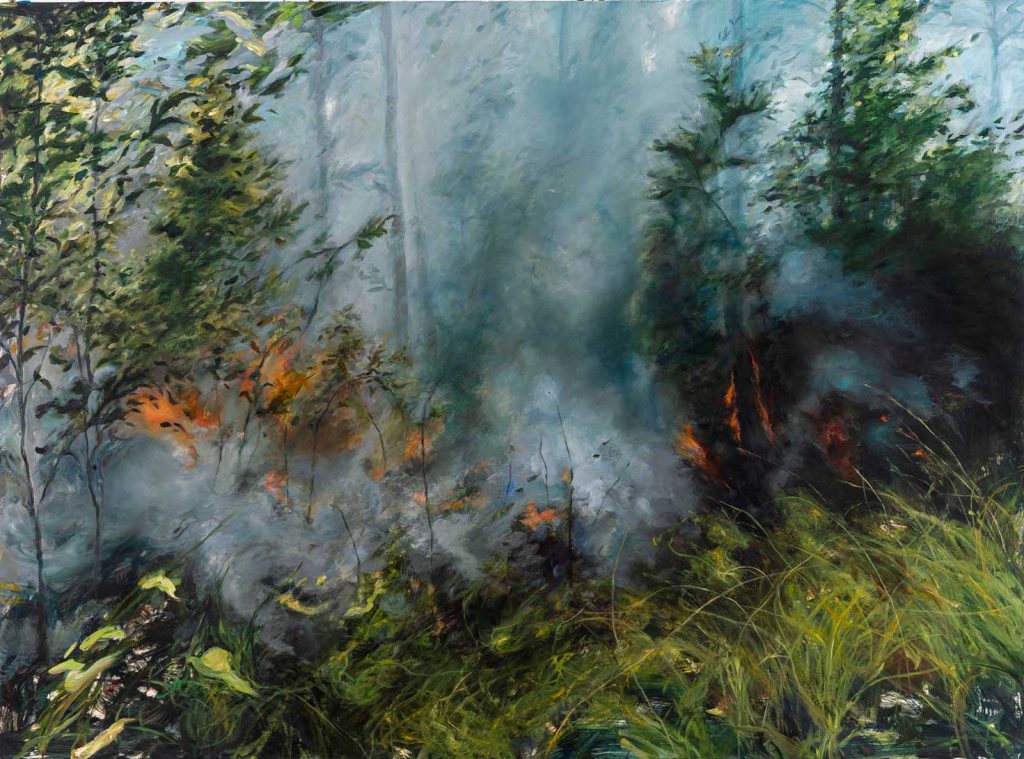
I first began the Controlled Burn series in 2009. At the time, my attraction toward this symbol was rooted in a personal encounter with one in childhood. A forest guide explained to my 3rd grade class that in forestry, prescriptive fire is a healing agent. Fire removes invasive species and returns nutrients back to the soil, renewing it. Learning that fire could be an agent for health and restoration was powerful. And given my interest in psychology, it was a symbol I carried closely for the parallels I could draw between fire and the effects of trauma. A slowly regenerating forest ground became a symbol for (and a promise of) resilience.
More recently, however, this series has taken on a completely different tone in light of our current ecological crisis. With the recent bushfires in Australia, a video [Mishandling of Fires in Australia] interview began circulating online featuring an Australian indigenous fire practitioner named Victor Steffensen. The interviewer asks, “What do you do? How is what you do different to the way the rest of the firefighting community operates?” Steffensen responds, “It’s totally opposite to what everyone is doing here. Everyone’s talking about the aftermath and it’s always the way Western society works–always acting when it’s too late. Whereas all the work I do is in prevention of that, not to save your own house, but to save the bushlands and look after the environment as a whole.” He goes on to explain that these devastating fires could have been completely avoided if frequent controlled burns had been regularly administered to the land. The practice of controlled burning is, in effect, preventative indigenous medicine.
It’s become apparent that much of our worldwide climate despair is a reckoning of settler colonialism and its practice of rampant resource exploitation, replacing indigenous ways of knowing and co-existing with nature. Through these climate-related crises, we are urgently being called to re-indigenize our ways of understanding and of living on this earth.
Artist’s Short
Mishandling of Fires in Australia

Lavett Ballard | Tawny Chatmon | Oletha DeVane | Shanequa Gay | Delita Martin | Elsa Muñoz | Renée Stout | exhibition page
 Works in the I See God in Us series are not only layered in textures and techniques but also in symbolism. The color blue is used throughout in varying shades. The color is a symbol of the night and representative of a magical and spiritual place; a place that is deeply grounded in cultural and oral histories that allow for the acceptance of magic in an otherwise rational world. The women in the works are magical beings that possess the power to transcend their black skin and existence in a spiritual form. Through the weaving of history and storytelling, they offer a new narrative on the power of women.
Works in the I See God in Us series are not only layered in textures and techniques but also in symbolism. The color blue is used throughout in varying shades. The color is a symbol of the night and representative of a magical and spiritual place; a place that is deeply grounded in cultural and oral histories that allow for the acceptance of magic in an otherwise rational world. The women in the works are magical beings that possess the power to transcend their black skin and existence in a spiritual form. Through the weaving of history and storytelling, they offer a new narrative on the power of women.
Working from oral traditions, vintage and family photographs as a source of inspiration; my work explores the power of the narrative impulse. My process of layering various printmaking, drawing, sewing, collaging, and painting techniques allows me to create portraits that fuse the real and the fantastic. In my work, I combine signs and symbols to create a visual language. By fusing this language with oral storytelling, I offer identities and narratives for women of color.
Biography | Resume
Biography
Delita Martin is an artist currently based in Huffman, Texas. She received a BFA in drawing from Texas Southern University and an MFA in printmaking from Perdue University. Formerly a member of the Fine Arts faculty at the University of Arkansas at Little Rock, Martin currently works as a full-time artist in her studio, Black Box Press.
Working from oral traditions, vintage and family photographs as a source of inspiration, Martin’s work explores the power of the narrative impulse. Her process of layering various printmaking, drawing, sewing collaging and painting techniques allow her to create portrait that fuse the real and the fantastic. In her work, she combines signs and symbols to create visual language. By fusing this visual language with oral storytelling, she offers other identities and other narratives for women of color.
Martin’s work has been exhibited both nationally and internationally. Most recently, Martin’s work was included in State of the Arts: Discovering American Art Now, an exhibition that included 101 artists from around the United States. She was also included in the International Review of African American Art as one of 16 African American artists to watch, as they are gaining national and international attention in 2015.
Delita Martin–Draw, Paint, Print: The Artist’s Process
Tea with Myrtis: Artistically Speaking with Delita Martin

Lavett Ballard | Tawny Chatmon | Oletha DeVane | Shanequa Gay | Delita Martin | Elsa Muñoz | Renée Stout | exhibition page
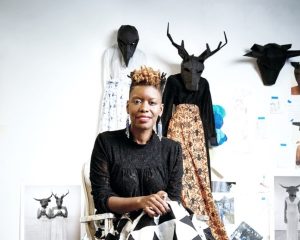 My work evaluates place, tradition, storytelling, and subject matter to develop imaginative dialogues and alternative strategies for self-imaging. Through installations, paintings, performance, video, and monumental sculptural figures, I am fabricating environments of ritual and memorial, depicting amalgamated images of new gods and mythical figures whose lives have been impacted by systemic inequalities. By developing counter and re-imagined narratives that live within the duality of physical and spiritual worlds, I am exploring the historical and contemporary social concerns of hybrid cultures, through the gaze of the African-Ascendant female progenitor.
My work evaluates place, tradition, storytelling, and subject matter to develop imaginative dialogues and alternative strategies for self-imaging. Through installations, paintings, performance, video, and monumental sculptural figures, I am fabricating environments of ritual and memorial, depicting amalgamated images of new gods and mythical figures whose lives have been impacted by systemic inequalities. By developing counter and re-imagined narratives that live within the duality of physical and spiritual worlds, I am exploring the historical and contemporary social concerns of hybrid cultures, through the gaze of the African-Ascendant female progenitor.
Photo Courtesy of Harold Daniels
Biography | Resume
Biography
Shanequa Gay, an Atlanta native, received her AA in Graphic Design and Fashion Marketing from the Art Institute of Atlanta (1999), a BA in Painting from The Savannah College of Art and Design (SCAD), summa cum laude (2015), and an MFA at Georgia State University. Gay was one of ten selected artists for OFF THE WALL a city-wide Mural initiative led by WonderRoot and the Atlanta Super Bowl Host Committee (2018). In 2013, Gay was chosen by The Congressional Club to be the illustrator for the First Lady’s Luncheon hostess gift for First Lady Michelle Obama. Gay’s work includes features in the Lions Gate film Addicted, the BET television series Being Mary Jane and Zoe Ever After, and the OWN series Greenleaf.
Video
Artist’s Short
The Crooked Room, 2018 by Shanequa Gay

Lavett Ballard | Tawny Chatmon | Oletha DeVane | Shanequa Gay | Delita Martin | Elsa Muñoz | Renée Stout | exhibition page
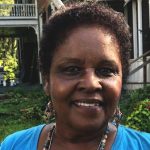 Biography | Resume
Biography | Resume
Biography
Oletha DeVane is multidisciplinary artist who explores diverse political, social identities and cultural interpretations. Her work is in permanent museum collections and she has exhibited at the Corcoran Gallery of Art, Museum of the Bible in NY, Museum of the Americas, The Reginald F. Lewis Museum, and the Baltimore Museum of Art.
She has served on several boards including Maryland Art Place, School 33, Wide Angle Youth Media, and The Build Haiti Foundation. She was the Program Director for the Maryland State Arts Council’s Individual Artist (1979-92) and Visual Arts programs (1990-92).
Ms. DeVane, is currently the Director of Tuttle Gallery and the former head of visual arts at McDonogh School in Owings Mills, MD. In 2007, she was a recipient of the Rollins/ Luetkemeyer Chair for Distinguish Teaching. Ms. DeVane is also the recipient of 2017 Rubys Grant, Art Matters, a Sondheim Semi-Finalist.
Video
Oletha DeVane speaks at the 2018 Women’s History Month Convocation at Morgan State University
watch the full ceremony at on YouTube
Artist’s Short

Lavett Ballard | Tawny Chatmon | Oletha DeVane | Shanequa Gay | Delita Martin | Elsa Muñoz | Renée Stout | exhibition page
 It is my belief that our memories and experiences are directly responsible for who we become. What we are exposed to, what we read, the toys we play with as children, what we view… I attribute this thought to my deep-seated desire to make sure I’m sending a clear message (with my work) and that the message I am sending is “saying something” important; because if I believe we are shaped by our memories, as an artist, I must also believe that I too play a small part in shaping and shifting the views of anyone who comes in contact with my life’s work.
It is my belief that our memories and experiences are directly responsible for who we become. What we are exposed to, what we read, the toys we play with as children, what we view… I attribute this thought to my deep-seated desire to make sure I’m sending a clear message (with my work) and that the message I am sending is “saying something” important; because if I believe we are shaped by our memories, as an artist, I must also believe that I too play a small part in shaping and shifting the views of anyone who comes in contact with my life’s work.
The primary theme that drives my art practice is celebrating the beauty of black childhood. I am devoted to creating portraits that are loosely inspired by works painted during the 15th-19th centuries with the specific intent of bringing to the forefront faces that were often under-celebrated in this style of work.
My camera remains my primary tool of communication, while my constant exploration of diverse ways of expression moves me to add several different layers using a variety of mediums. After a portrait session is complete, I typically digitally manipulate my subjects and unite them with other photographic components to achieve a work that is a new photographic expression. Often lending to them the eyes of someone their elder and more wise and almost always exaggerating their hair and features in a somewhat rebellious celebratory way (in doing so, I unapologetically honor traits and characteristics often deemed unsightly in Western culture). Thereafter, I may superimpose antique patterns and textures, vintage botanical and wildlife illustrations or hand drawn digital illustration. If I feel I am not yet complete, after each portrait is refined and printed, I may combine paint and gilding adding ornamental elements inspired by 19th century artworks.
It is my hope that with each theme I explore and with each portrait I create, something vital is etched into the memory of the viewer.
Biography | Resume
Biography
My work and life have gone through many phases that have lead me to create the work I do today. I attribute this evolution to three major shifts: The decision to no longer pursue a career in dramatic arts, the birth of my first child and the death of my father.
Before becoming a photographer, I was a performer. My early childhood consisted of traveling from continent to continent as an “army brat”. After settling in the United States, my pre-teens to early adulthood was spent performing in plays put on by my aunts theater company, dinner theatre programs, school plays, attending acting workshops and the like. After receiving a small scholarship for dramatic arts in High School I enrolled in a dramatic arts conservatory, was cast in an off Broadway play, had been an extra in just enough films making me eligible to receive my Union card…and out of nowhere, I quit. Having no idea what to do next or how I would creatively earn a living, I turned to photography.
At 19, I was gifted my first camera. Photography was not new to me although considering it a career choice was. I floated through ages 20-24 self-teaching, exploring with various genres of photography and using my camera as a means of making a living. During this time, I also began learning Photoshop and taking on graphic and web design jobs.
Photographing children was something that never crossed my mind before becoming a mother. After the birth of my son, my life organically became about documenting his life. Ages 25-28 were almost exclusively dedicated to my joy of photographing him. This expanded to documenting these moments for family members which then lead to offering to do so for other families as well.
My first experience working in commercial photography came after being recommended by a client for a local commercial job. Afterwards, I began to seriously pursue other opportunities shooting for (or providing photographs for) YMCA, Until There’s a Cure and NEA and publications such as Vogue Bambini, Parenting Magazine & Baby Talk Magazine.
In 2010, my outlook and relationship with my camera changed when I began photographing my father’s battle with cancer. What we thought would be a testimony of his victory turned out to be my documentation of cancer taking his life. Not much felt worthy of picking up my camera for after that. With his passing, something in me died, but something else awakened. I began to stop solely looking to my camera as a means of making a living and began using it as a way to communicate my joy, my pain & my frustration.
Now 39, I look to photography less as a career or a job and more as a calling. My work is ever-changing and constantly evolving as am I. The portraits I create today are almost always inspired by my children and usually of someone that I am close to in some way (my daughters, son, God daughter, a relative, or a model that I’ve worked with in the past) and is driven by my desire contribute something important to a world that I want my children to thrive in.
Artist’s Short
One to Watch: Tawny Chatmon

Lavett Ballard | Tawny Chatmon | Oletha DeVane | Shanequa Gay | Delita Martin | Elsa Muñoz | Renée Stout | exhibition page
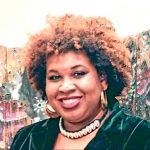
As a child, I would spend summers at our family farm in Virginia. This ritual of traveling from the North to the South all the while being fed the stories of how we grew to gain the property and how the “Big House” I would be staying in was built by my three times great grandmother’s sons. The house was a step back in time prior, to the flight of the Great Migration which sent masses toward opportunities in the North. Through this experience, I was drawn to the history of the log cabin that held generations of my family in a home surrounded by photographs that chronicled our history.
This experience helped to foster an interest in visual storytelling while fusing the wood that surrounded me during the summers of my youth. My strong affinity for imagery and history has led me to focus on creating a visual lexicon of the African American experience and self-identity.
I’ve spent hours compiling a photographic catalog of female and male images that cover the African diaspora over different geographic areas and historic periods. The prints are collaged, painted, destroyed and reborn to create a re-imagined visual narrative. I use reclaimed large and small aged wood fences, as a symbolic reference to how fences keep people in and out, just as racial and gender identities can act as barriers in our socially. These fences are then arranged as ‘altars’ as icons to honor the strength and determination of each subject.
Biography | Resume
Biography
Lavett Ballard is an Artist, Art historian, Curator, and Author. She hold a dual Bachelor’s in Studio Art and Art History with a minor in Museum Studies from Rutgers University, and an MFA in Studio Art from the University of the Arts in Philadelphia.
Ballard’s art has been included in literary, film and theatre productions and museum, galleries, public, private institutions and exhibitions nationwide. Among other accolades I have been named by Black Art in America as one of the Top 10 Female Emerging Artists to Collect and has been nominated for the inaugural Art for Social change Pew Foundation funded Residency among other distinguished honors. Her work has been acquired by prominent collections such as the Smithsonian, the African American Museum of Philadelphia, the T. Thomas Fortune Cultural Center, Weeksville Heritage Center, the Petrucci Family Foundation Collection and the Grant and Tamia Hill private Collections.
Ballard views her art as a re-imagined visual narrative of people of African descent. Her use of imagery reflects social issues affecting primarily Black women’s stories within a historical context. Her current body of work uses collaged photos adorned with paint, oil pastels, and metallic foils. These photos are deconstructed and layered on reclaimed large and small aged wood fences. The use of fences is a symbolic reference to how fences keep people in and out, just as racial and gender identities can do the same socially. The fusion of wood and photography offers artwork that both explores her southern roots, visually speaks volumes to continuing themes within her community.

Artists | Artwork | Videos | Exhibition Catalog
Women Heal through Rite and Ritual draws from the imaginative narratives of artists Lavett Ballard, Tawny Chatmon, Oletha DeVane, Shanequa Gay, Delita Martin, Elsa Muñoz and Renée Stout who look to non-Western traditions for inspiration in exploring a woman’s role as nurturer of family and community; and as traditional healer, conjure woman, and clairvoyant who dwells in both the physical and spiritual realms.
As giver of life, custodian of traditional African religion and customs, preserver of culture, counselor, and psychologist, and at times, the conduit between two worlds, Women Heal through Rite and Ritual celebrates and reclaims a woman’s power and place in the natural and supernatural worlds.
As the COVID-19 (coronavirus) continues to permeate every aspect of our lives, we recognize the need to take preventative measures in order to ensure the safety of our staff, our artists, and our patrons. While the gallery remains closed, we offer an online version of our current exhibition Women Heal through Rite and Ritual. We are planning to hold the opening reception and artist talk in the future. However, because of the fluidity of the situation, no date will be announced at this time. Until then enjoy the online exhibition!

Solo Exhibition featuring Wesley Clark
September 22 – October, 31, 2019
artwork | artist statement | curatorial statement | about Wesley Clark
Artist Statement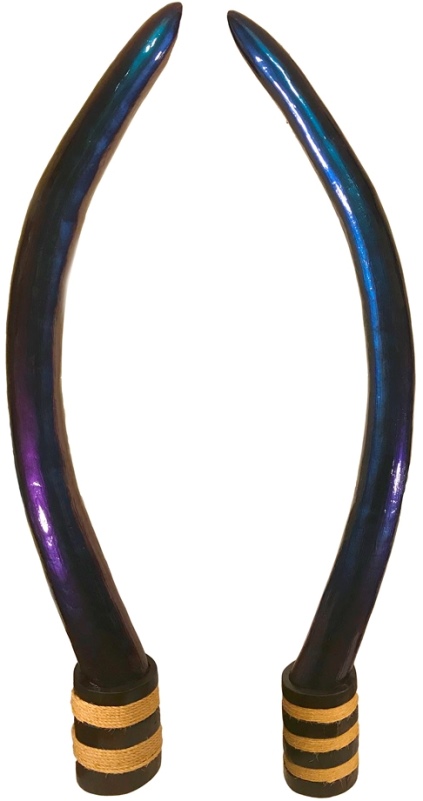
The exhibition, Reparations: Some Things are Just Owed, and Some More than Others, showcases a selection of objects created by a recently discovered artisanal-based company, Reparations & Co. Reparations & Co. (a.k.a. Rep & Co.) founded by Eugene & Morris, two Black men during the Reconstruction era, created functional, subversive, and empowering objects — some futuristic in thought and process. Not much is known about the craftsmen or the company, however, in recent years several objects have surfaced on the auction and secondary markets with the company’s logo, prompting research. As such, researchers discovered what is believed to be their shop in an overgrown, abandoned, dilapidated barn-like structure near Freetown, in Glen Burnie, MD. The collection found is vast and while remarkably well preserved, some objects were vandalized, prompting restoration efforts. On display in this exhibition viewers get a peek into the past through the minds of two craftsmen as they fuse economic empowerment, restoration of identity, and more into their functional and decorative objects; during a pivotal yet short-lived period of American history.
The fictitious narrative of Reparations & Co. is what drives many of the aesthetic choices; it is the vehicle used to create a dialogue on ideas of racial socialization — as described in Post Traumatic Slave Syndrome, by Dr. Joy DeGruy — as a means of expanding and internalizing the discussion of reparations to include what we as Black Americans owe ourselves.
“…the process whereby we come to know our strengths, understand the world in which we live, and position ourselves to thrive. Continual education is at the heart of racial socialization. For young children, education is the elder’s responsibility. For adults, the responsibility is our own. We have to remain vigilant and questioning. We have to continue to constantly endeavor to keep ourselves informed and our education current. We have to question the image we ourselves are portraying. We have to examine the sounds and pictures we expose ourselves to. We have to filter what we hear on the news and strive to understand what is true.“
– Joy DeGruy, Post Traumatic Slave Syndrome
watch Joy DeGruy lecture on Post Traumatic Slave Syndrome
Whether from present day or generational trauma, communal preparation and advancement are at the heart of this body of work. Under the umbrella of preparation, inwardly focused themes around mental health, family history and legacy, self-respect and dignity, leadership, rebuilding the Black economy and restoring relationships are touched on as a means of being solution-oriented. While there are outside influences discussed on the traditional theme of reparations, the focus remains inward. Two examples of such influences can be found when examining the works The Profiteers 1 & The Profiteers 2. The first recognizes existing companies operating in the US (though possibly under a new name) that profited from the enslavement of Africans. The second names corporations that have or still use prison labor and thereby support the growth of the prison industrial complex (i.e., Sprint, Verizon, Bank of America and Walmart). My intent is to think about self-respect, as well as building and supporting a Black economy, as each name listed represents an industry for the Blacks to build and compete in.
A large portion of my work considers aging, weathering, and/or antiquing objects driven by fictional narratives, which informs my aesthetic choices. Most often this process is about linking present day content to historical issues, or ideas around value. Objects that are salvaged and displayed are deemed to possess a certain value or esteem. I set the stage for that sense of value to be linked to contemporary socio-political or socio-economic issues and conversations. With this body of work, I’ve chosen to incorporate custom automotive high gloss paints — often used on “tricked out” or restored cars — as a contemporary reference to notions of value. These “candy” or “flip flop/color shifting” paints are typical for early/classic model cars souped up with big, fancy rims, chrome details, or engine/body modifications. These cars have been popularized by rap culture in particular and therefore are associated with money, fame, and all that comes with it — just as owning a certain antique furniture piece once were — hence speaks to a younger generation’s value system. Such paints were incorporated into the works, Restoring our Majesty, Wading in the Waters of Babylon, and The Tell-All Earbox: Model no. C3l3stial-4, as one of two visual elements — the other being “tagging”/graffiti writing — to fuse the temporal space between the antique lover and millennial mind.
I’m not concerned with the viewer engaging my personal narratives that drive the work. More often than not, they’re just for me and my process. Reparations & Co. marks the first time my working narrative has held an elemental position (in the form of a logo placed on a few works) and thus a larger more robust storyline has emerged. I work with fictitious narratives as a means of setting a stage for myself mentally — and every stage has its props and boundaries. Therefore I’m constantly questioning, “Does this idea/object fit within the boundaries of my stage and how?” The objects (props) I choose to create are often ubiquitous, even mundane items with slight hybridity-like aspects tossed in for good measure. For the viewer, it’s the objects’ familiarity — loaded with preconceived notions and understandings – that allow entryway. With that familiarity in place, the stage is set for viewers to explore the relationship with the “foreign” social and/or political elements incorporated into the work.